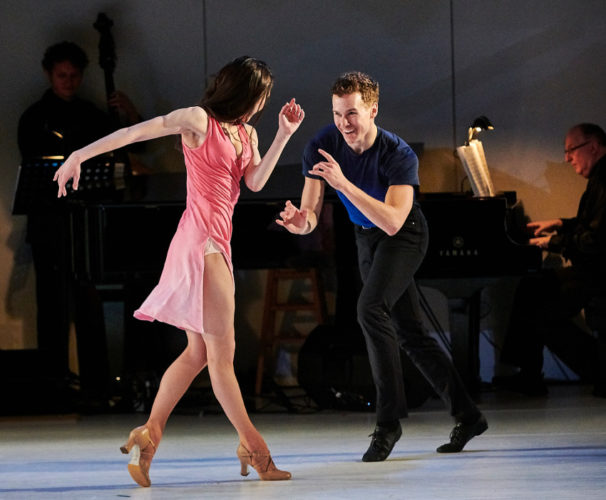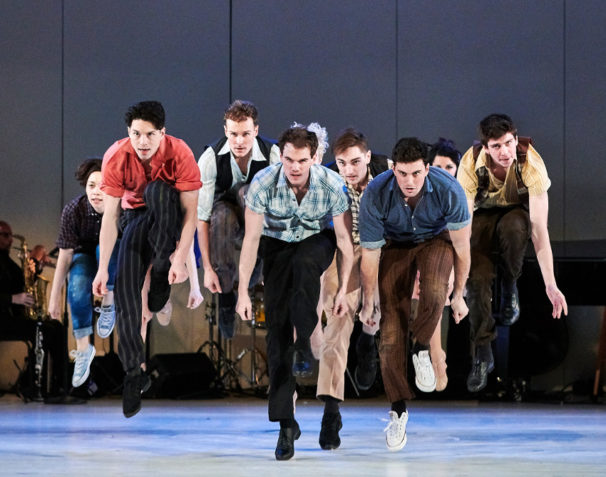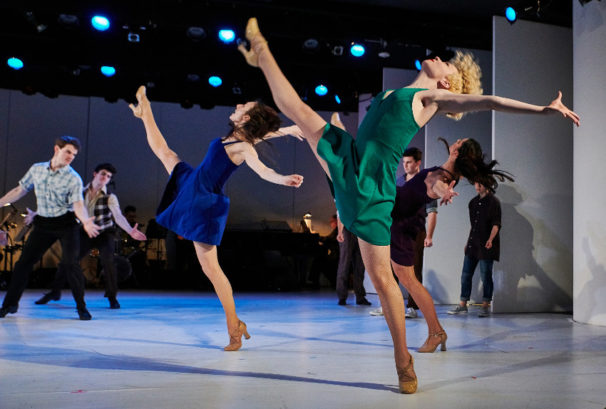
“Jerome Robbins’ Broadway 30th Anniversary Celebration,” a lovingly assembled, heartfelt 90-minute program presented in the Guggenheim Museum’s “Works & Process” series, was several events bundled into one. It was a loving coda to the Jerome Robbins Centennial; an enthusiastic alumni reunion; and a celebration of a landmark Broadway production exactly 30 years after its opening on February 26, 1989.
The event was co-conceived by Nikki Feirt Atkins, who is Producing Artistic Director of American Dance Machine for the 21st Century; Robert La Fosse, who staged the numbers; and Jerome Robbins’ Broadway cast member Barbara Hoon. The well-paced program opened with On the Town (1944), Robbins’ first Broadway musical.

Leading the way with “New York, New York” as high-flying sailors bounding into the Brooklyn Navy Yard were Michael Kubala, Christophe Caballero and La Fosse. They performed just enough choreography to impress with their abilities 30 years later, then were succeeded by a younger wave of sailors, led by the central trio who made the show’s 2014 Broadway revival so terrific – Tony Yazbeck, Jay Armstrong Johnson and Clyde Alves. (That production had choreography by Joshua Bergasse.)
A good number of original cast members were on stage to strut their stuff – most notably, the three who portrayed the hilariously down-and-out strippers in the wise and witty “You Gotta Have a Gimmick” from Gypsy.
Gypsy‘s down-on-their-luck strippers were reprised by Debbie Gravitte – still playing a mean trumpet as Mazeppa — Susann Fletcher and Faith Prince. Wearing black outfits with identifying touches of their original costumes, they performed much of the choreography designed illustrate the words that launch the number, “To be a stripper, all you need is no talent.”

Bump it with a trumpet!
Staś Kmieć, the choreographer of the Yiddish Fiddler at Stage 42 and Fiddler expert staged the Fiddler on the Roof wedding scene for the enterprising youngsters of Rosie’s Theater Kids – from the calm poignancy of “Sunrise, Sunset” (sung by two original cast members) all the way through the bottle dance and the increasingly frenzied group sequences.

La Fosse, still in sailor suit, adding reading glasses as needed, provided informative commentaries throughout the program. He was one of the three dancers on whom Robbins choreographed a menage a trois dance to follow the Irving Berlin song “Mr. Monotony” – performed by its inimitable 1989 interpreter Debbie Gravitte, one of the musical’s three Tony winners. Gravitte’s understated, bluesy performance of the song – her intense stillness an exciting contrast to the show’s bounty of movement – was a highlight in 1989. She still owns the song.

The “Mr. Monotony” dance has been kept alive by American Dance Machine for the 21st Century – a plucky ensemble preserving classic Broadway dance numbers. Ahmad Simmons, Skye Mattox and the exceptional Ryan Steele (in La Fosse’s role) performed it with deft timing and fearless attack.

“Cool” from West Side Story (1957) was left to the younger generation. Seven men and three woman gave it an earthier, angrier flavor than it usually gets as part of Robbins’ West Side Story Suite that’s become a mainstay of New York City Ballet’s repertory. La Fosse, who worked extensively with Robbins as a NYCB principal as well as in the 1989 show, observed, “To me that dance is a masterpiece,” citing the brilliance of the structure that underlies its timeless visceral impact.

Two panel discussions interspersed between numbers, moderated by Steven Suskin, conveyed war stories of working on the show – which had an unheard-of 22-week rehearsal period, a cast of 60, seven weeks of Broadway previews, and a new high ticket price of $55.
Jerry Mitchell, one of today’s leading Broadway director-choreographers, was a Robbins assistant in 1989. He described a meticulous, two-year process – reaching out to long-ago collaborators, digging up original cast members in the hope they could recall certain choreography.
All these years later, Mitchell said as the panel followed “Mr. Monotony,” “I could hear Jerry talking in my ear as I watched them perform.” Working on the production, he said, “was a master class, or graduate school – for me.”
Others recalled the fortunate discovery of a kinescope of a TV performance that helped Robbins to reconstruct the complex and hilarious “Bathing Beauty ballet” from High Button Shoes (1947). A film of a 1989 performance was shown so we could experience the number in all its densely populated zaniness – and we were assured that the “choreography” backstage had been even more complicated. All attested to their awe, respect – and in most cases, affection – for Robbins, even after going through occasional conflicts with the notoriously difficult perfectionist. Faith Prince recalls insisting on a certain pause that Robbins didn’t want, and finally winning him over.
A six-piece American Dance Machine for the 21st Century Band provided essential, expert accompaniment. They were positioned far upstage on the Guggenheim’s notoriously tiny circular stage, which somehow was able to hold multitudes.
Always a master of timing, Robbins sensed at 70 that the time was right to present a unique compilation of his work. In delightful rehearsal footage screened before the live show, Robbins was still energetic and nimble enough to demonstrate vividly. Jerry’s kids — and grandkids — all clustered around his memory for this evening of exuberance, nostalgia and celebration.
Susan Reiter covers dance for TDF Stages and contributes regularly to the Los Angeles Times, Playbill, Dance Australia and other publications.

photo credit: robert altman
